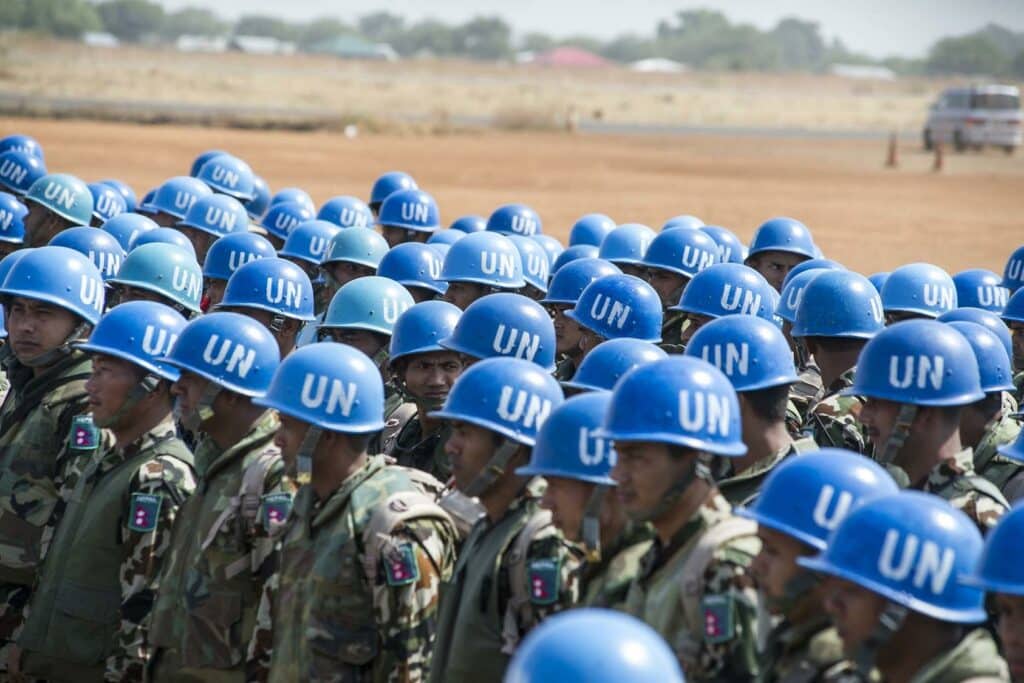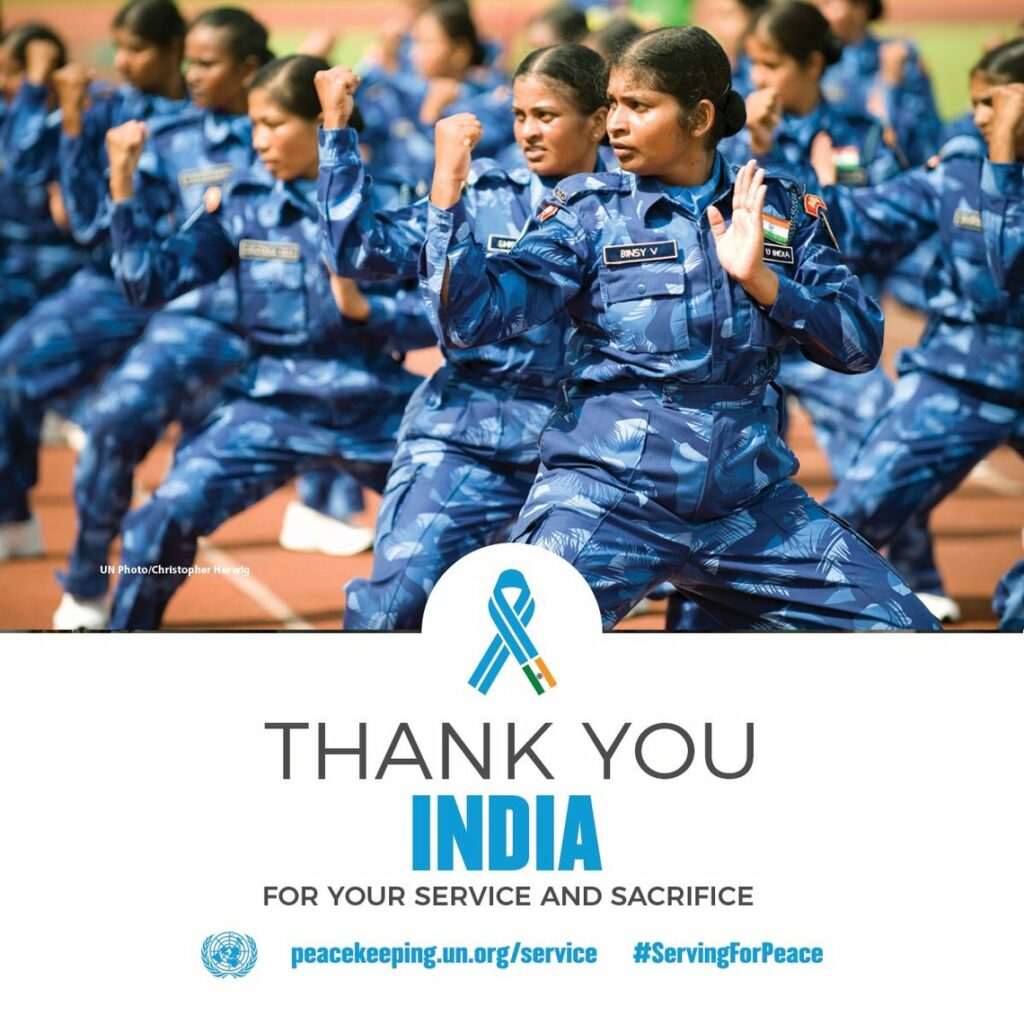- Peacekeeping by the United Nations is a role held by the Department of Peace Operations as an “instrument developed by the organization as a way to help countries torn by conflict to create the conditions for lasting peace”.
- UN Peacekeepers monitor and observe peace processes in post-conflict areas and assist ex-combatants in implementing the peace agreements they may have signed.
- Such assistance comes in many forms, including confidence-building measures, power-sharing arrangements, electoral support, strengthening the rule of law, and economic and social development.
- The first time UN Peacekeeping Forces were first deployed in 1948 when the UN Security Council authorized the deployment of UN military observers to the Middle East.
- Accordingly, UN peacekeepers (often referred to as Blue Berets or Blue Helmets because of their light blue berets or helmets) can include soldiers, police officers, and civilian personnel.
- The United Nations Charter gives the United Nations Security Council the power and responsibility to take collective action to maintain international peace and security.
- For this reason, the international community usually looks to the Security Council to authorize peacekeeping operations through Chapter VII authorizations.
- Most of these operations are established and implemented by the United Nations itself, with troops serving under UN operational control. In these cases, peacekeepers remain members of their respective armed forces, and do not constitute an independent “UN army”, as the UN does not have such a force.
- In cases where direct UN involvement is not considered appropriate or feasible, the Council authorizes regional organizations such as NATO, the Economic Community of West African States, or coalitions of willing countries to undertake peacekeeping or peace-enforcement tasks.
Financing
- The financial resources of UN Peacekeeping operations are the collective responsibility of UN Member States.
- Decisions about the establishment, maintenance or expansion of peacekeeping operations are taken by the Security Council.
- Peacekeeping expenses are divided by the General Assembly based upon a formula established by Member States which takes into account the relative economic wealth of Member States among other things.
Structure
- A United Nations peacekeeping mission has three power centres –
- The first is the Special Representative of the Secretary-General, the official leader of the mission
- This person is responsible for all political and diplomatic activity, overseeing relations with both the parties to the peace treaty and the UN member-states in general.
- The second is the Force Commander, who is responsible for the military forces deployed.
- They are a senior officer of their nation’s armed services, and are often from the nation committing the highest number of troops to the project.
- The Chief Administrative Officer oversees supplies and logistics, and coordinates the procurement of any supplies needed.
- The first is the Special Representative of the Secretary-General, the official leader of the mission

India and UN Peacekeeping
- India stands solidly committed to assist the UN in the maintenance of international peace and security with a proud history of UN peacekeeping dating back to its inception in the 1950s.
- Also, India’s unique combination of being the largest democracy in the world with a strong tradition of respect for rule of law and the successful experience in nation building makes it particularly relevant in the context of twenty-first century peacebuilding.
- India today is the largest contributor of troops to UN peacekeeping operations (UNPKOs).
- More than 200,000 Indian troops have served in 49 of the 71 UNPKOs deployed so far.
- India is the second largest troop contributor [TCC] with 7,676 personnel deployed in 10 out of 16 active UN Peacekeeping Missions.
- In 2007, India became the first country to deploy an all-women contingent to a UN Peacekeeping mission.
- In the last six decades, 179 Indian soldiers have died in UN Peacekeeping operations. Among “blue helmets” it has the greatest death toll of any nation.
The following have been the notable missions in which India has contributed since 1950.
| Mission | Details |
|---|---|
| Korea (1950-54) | To facilitate withdrawal of sick and wounded in Korea. |
| Indo-China (1954-70) | India provided an Infantry Battalion and supporting staff for control of Indo-China comprising three states of Vietnam, Cambodia and Laos. Tasksincluded monitoring, ceasefire and repatriation of prisoners of war, among other. |
| Middle East (1956-67) | United Nations Emergency Force (UNEF), where for first timearmed troop contingents were deployed. India’s contribution was an infantry battalion and other support elements. |
| Cambodia (1992-1993) | Was set up to supervise ceasefire, disarmcombatants, repatriate refugees and monitor conduct of free and fair elections. |
| Lebanon (Since 1998) | The current situation in the Mission is tense and volatile due to the crises in Syria. And India has provided One infantry battalion group, along with hospital staff for the mission. |
| Sudan (Since 2005) | The latest political developments in the Mission led to widespread inter-tribe violence and large displacement of locals. The current situation continues to be highly volatile and sporadic clashes between the tribes are being reported regularlyIndia has contributed two Infantry Battalion groups, and Engineering assistance. |
What are the most probable reasons for Fatalities?
- The atmosphere in which peacekeeping operations are taking place is getting worse from both a political and a security point of view.
- Many operations, especially large operations like those in Africa, engage soldiers against criminal or terrorist organization who prefer turmoil over peace and stability.
How can these fatalities be controlled?
- Geographical equilibrium and evenness must be maintained in peacekeeping operations.
- It will necessitate a great deal of effort to increase the geographical diversification of the nations providing police and peacekeeping forces.
- India has presented a 10-point formula to address security and operational challenges faced by United Nations peacekeeping missions around the world.
- To accomplish the objectives of operations, the leadership of a peacekeeping force must build confidence and ensure efficient cooperation with the host state.
- Countries participating in peacekeeping missions must determine the agenda, not the Security Council.
- With a thorough understanding of their limits, peacekeeping missions should be deployed sensibly.
- Clearly defined objectives that are supported by adequate resources.
- “All-out efforts” should be made to prosecute those responsible for atrocities against peacekeepers.
- It is essential for ending violent conflicts and constructing global security against external threats.
- Using cutting-edge technology in peacekeeping operations can help overcome security issues.
- The military, civilians, and mission leadership should all be considered while evaluating a mission.
- An “exit strategy” should be considered for peacekeeping deployments from the beginning.
- The primary duty to safeguard people against non-state groups operating on their soil shall rest with the host government.
Is UN Peacekeeping Losing its Appeal?
- Until the collapse of the Soviet Union in 1991, most global conflicts were driven by competition between the United States and the Soviet Union, creating the need for an impartial army to stand between them.
- But, most modern conflicts, whether in Bosnia-Herzegovina and Rwanda during the 1990s or in Syria and Iraq today are too messy and chaotic for the old model of peacekeeping to work.
- The factors that allow for effective peacekeeping aren’t in existence anymore; as the same factions that allow for an easy creation of cease-fire do not exist anymore.
- Also, there is the lack of public support in Western nations for the costly and sometimes dangerous missions.
- Ex: France leads the counterterrorism mission in Mali but is working to reduce its involvement and end the mission, in part because of domestic pressure and an upcoming election.
- Further, waning support for peacekeeping in the West is rippling into sub-Saharan Africa.
- Neither Malian nor Somali forces are capable of filling the gap left by peacekeepers and other foreign forces if and when they withdraw.
- The withdrawal from Afghanistan marks the end of an era, and for now the end of enduring stabilization operations in distant places.
- It provides an opportunity for all Western nations to reconsider the use of their military as an instrument of their foreign policy.
UN Peacekeeping: Critical Analysis
- Positive Impacts
- There is strong evidence that the presence of peacekeepers significantly reduces the risk of renewed warfare; more peacekeeping troops leads to fewer battlefield and civilian deaths.
- There is also evidence that the promise to deploy peacekeepers can help international organizations in bringing combatants to the negotiation table and increase the likelihood that they will agree to a cease-fire.
- Concerns
- There have been several reports during UN peacekeeping missions of human rights abuse by UN soldiers, notably in Central African Republic in 2015.
- The cost of these missions is also significant, with the mission in South Sudan costing $1 billion per year for 12,500 UN soldiers unable to prevent the country’s movement towards civil war.
- Also, Often missions require approval from local governments before deploying troops which can also limit effectiveness of UN missions.
- A 2021 study in the American Political Science Review found that the presence of UN peacekeeping missions had a weak correlation with rule of law while conflict is ongoing, but a robust correlation during periods of peace.
Way forward:
- Brahimi analysis
- The Brahimi Report was the first of many steps to recap former peacekeeping missions, isolate flaws, and take steps to patch these mistakes to ensure the efficiency of future peacekeeping missions.
- The UN has vowed to continue to put these practices into effect when performing peacekeeping operations in the future, which include:
- the harmonization of the conditions of service of field and headquarters staff.
- the development of guidelines and standard operating procedures.
- Need for Rapid reaction force
- To prevent delays in action and deployment, a standing group, administered by the UN and deployed by the Security Council, that receives its troops and support from current Security Council members and is ready for quick deployment in the event of future genocides could be helpful.
- Reforms needed in United Nations peace and security architecture
- This should have an overall objective of reducing fragmentation for better delivery, to make the peace and security pillar more coherent, nimble and effective by prioritizing prevention, sustaining peace and delivery on Agenda 2030.
- Other reforms efforts in this perspective include
- Capstone Doctrine (2008), outlining the most important principles and guidelines for UN peacekeepers in the field;
- Peace Operations 2010 (2006), containing the reform strategy of the Department of Peacekeeping Operations (DPKO);
- 2005 World Summit establishing the Peacebuilding Commission;
- High-level Panel on Threats, Challenges and Change , setting out a broad framework for collective security for the new century.

